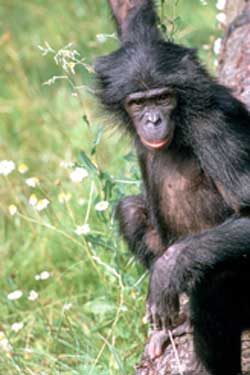Bonobo genome completed

Ulindi, the female bonobo from which the genome was sequenced, in the Leipzig zoo. Michael Seres<br>
In a project led by the Max Planck Institute for Evolutionary Anthropology in Leipzig, an international team of scientists has completed the sequencing and analysis of the genome of the last great ape, the bonobo.
Bonobos, which together with chimpanzees are the closest living relatives of humans, are known for their peaceful, playful and sexual behaviour that contrasts with the more aggressive behaviour of chimpanzees. The genome sequence provides insights into the evolutionary relationships between the great apes and may help us to understand the genetic basis of these traits.
The genome was sequenced from Ulindi, a female bonobo who lives in the Leipzig zoo. Genome sequences have also been generated from all other great apes – chimpanzee, orang-utan and gorilla – making this the final genome of a great ape to be sequenced and providing insights into their relationships with one another and with humans.
The comparison of the genome sequences of bonobo, chimpanzee, and human show that humans differ by approximately 1.3% from both bonobo and chimpanzee. Chimpanzees and bonobos are more closely related, differing by only 0.4%.
Bonobo and chimpanzee territories in central Africa are close to one another and separated only by the Congo River. It has been hypothesized that the formation of the Congo River separated the ancestors of chimpanzees and bonobos, leading to these distinct apes. Examination of the relationship between bonobos and chimpanzees showed that there appears to have been a clean split and no subsequent interbreeding, which supports this hypothesis.
Despite the fact that on average the genomes of bonobos and chimpanzees are equally distant from human, analysis of the genome sequence of the bonobo revealed that for some particular parts of the genome, humans are closer to bonobos than to chimpanzees, while in other regions the human genome is closer to chimpanzees. Further research will determine whether these regions contribute in any way to the behavioural differences and similarities between humans, chimpanzees, and bonobos.
Original work:
Kay Prüfer, Kasper Munch, Ines Hellmann, Keiko Akagi, Jason R. Miller, Brian Walenz, Sergey Koren, Granger Sutton, Chinnappa Kodira, Roger Winer, James R. Knight, James C. Mullikin, Stephen J. Meader, Chris P. Ponting, Gerton Lunter, Saneyuki Higashino, Asger Hobolth, Julien Dutheil, Emre Karakoç, Can Alkan, Saba Sajjadian, Claudia Rita Catacchio, Mario Ventura, Tomas Marques-Bonet, Evan E. Eichler, Claudine André, Rebeca Atencia, Lawrence Mugisha, Jörg Junhold, Nick Patterson, Michael Siebauer, Jeffrey M. Good, Anne Fischer, Susan E. Ptak, Michael Lachmann, David E. Symer, Thomas Mailund, Mikkel H. Schierup, Aida M. Andrés, Janet Kelso, Svante Pääbo
The bonobo genome compared with the chimpanzee and human genomes
Nature June 12 2012, DOI: 10.1038/nature11128
Contact:
Dr Kay Prüfer
Max Planck Institute for Evolutionary Anthropology
Tel: +49 341 3550 506
Email: pruefer@eva.mpg.de
Janet Kelso
Max Planck Institute for Evolutionary Anthropology
Email: kelso@eva.mpg.de
Media Contact
More Information:
http://www.eva.mpg.de/bonobo-genome/All latest news from the category: Life Sciences and Chemistry
Articles and reports from the Life Sciences and chemistry area deal with applied and basic research into modern biology, chemistry and human medicine.
Valuable information can be found on a range of life sciences fields including bacteriology, biochemistry, bionics, bioinformatics, biophysics, biotechnology, genetics, geobotany, human biology, marine biology, microbiology, molecular biology, cellular biology, zoology, bioinorganic chemistry, microchemistry and environmental chemistry.
Newest articles

Why getting in touch with our ‘gerbil brain’ could help machines listen better
Macquarie University researchers have debunked a 75-year-old theory about how humans determine where sounds are coming from, and it could unlock the secret to creating a next generation of more…

Attosecond core-level spectroscopy reveals real-time molecular dynamics
Chemical reactions are complex mechanisms. Many different dynamical processes are involved, affecting both the electrons and the nucleus of the present atoms. Very often the strongly coupled electron and nuclear…

Free-forming organelles help plants adapt to climate change
Scientists uncover how plants “see” shades of light, temperature. Plants’ ability to sense light and temperature, and their ability to adapt to climate change, hinges on free-forming structures in their…





















